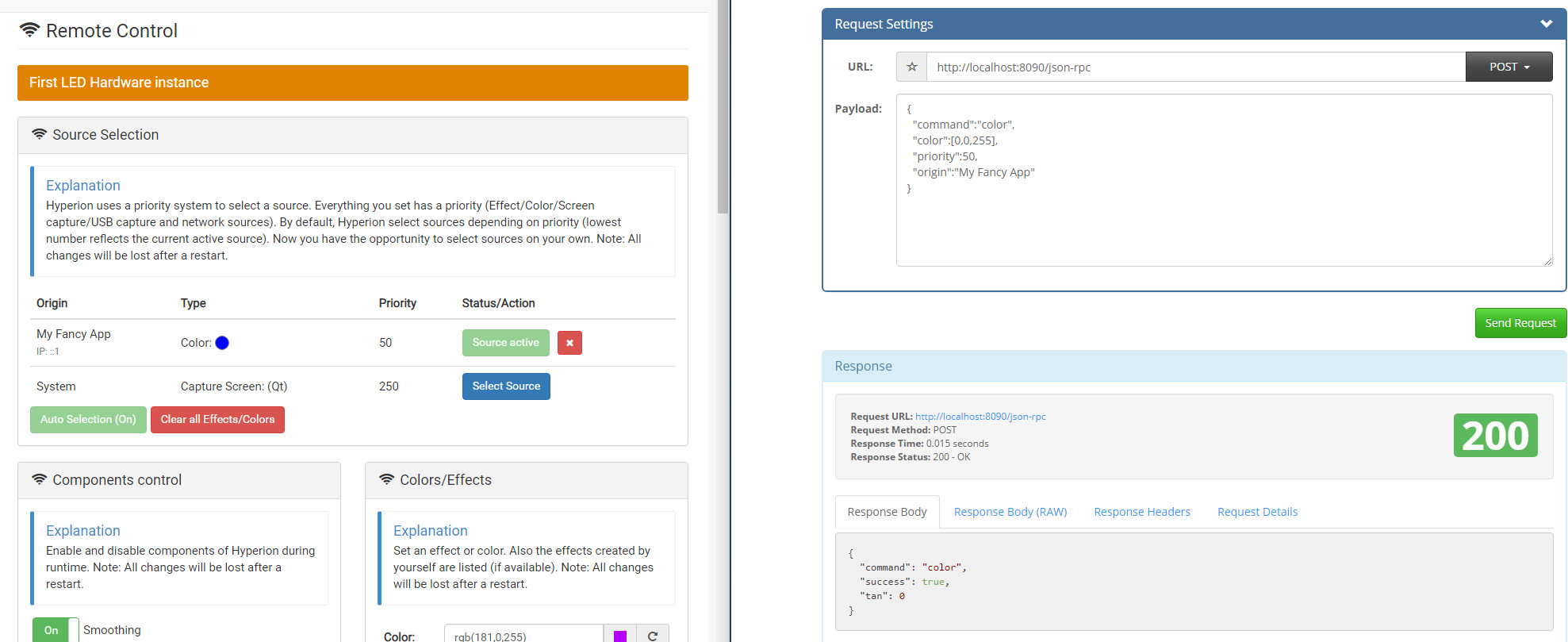JSON RPC Introduction
The JSON-RPC interfaces provides many ways to interact with Hyperion. You can retrieve information about your server, your instances and take actions (such as setting a priority input).
What is JSON?
JSON is a standardized message format (see JSON.org) and is supported by most programming languages. It is human readable which makes for easier debugging.
Sending JSON
Hyperion requires a specially formatted JSON message. A command argument is always required. A tan argument is optional. This is an integer you can freely choose -- it is part of the response you will receive to allow you to filter the response from other server messages (this functionality is likely necessary for advanced usecases only).
{
"command" : "YourCommand",
"tan" : 1
}Depending on the command, there might be an additional subcommand required:
{
"command" : "YourCommand",
"subcommand" : "YourSubCommand",
"tan" : 1
}Response
Most messages you send will trigger a response of the following format:
{
"command" : "YourCommand",
"info":{ ...DATA... },
"instance": 0,
"success" : true,
"tan" : 1
}- command: The command you requested.
- tan: The tan you provided (If not, it will default to 0 in the response).
- instance: Instance# sent the update
- success: true or false. If false, an error argument will contain details of the issue.
- info: The data you requested (if any).
Connect
Hyperion currently supports multiple connection mechanisms: TCP Socket ("Json Server"), WebSocket and HTTP/S.
TIP
You can automatically discover Hyperion servers! See Detect Hyperion
TCP Socket
This is a "raw" connection, you can send and receive line-separated json from the server (default port: 19444). This is also known as the "Json Server".
WebSocket
This is part of the Hyperion webserver (default port: 8090). You send and receive json commands. WSS is also supported on port 8092. Only TEXT mode is supported. Read more about websockets at Websocket.
HTTP/S Json
HTTP requests can also be sent to the webserver (default port: 8090, for HTTPS: 8092). Send a HTTP/S POST request along with a properly formatted json message in the body to the (example) url: http://IpOfDevice:WebserverPort/json-rpc
TIP
If you get a "No Authorization" response, you need to create an Authorization Token
HTTP/S Restrictions
Please note that the HTTP JSON-RPC lacks of the following functions due to technical limitations.
- Image streams, led color streams, logging streams, subscriptions
API
Server Info
A large variety of data is available from the server: Server Info
Control
Control your Hyperion server: Control
Authentication
Authentication mechanisms: Authentication
Subscribe
Data subscriptions: Subscribe
3rd Party Libraries
- Hyperion-py is a 3rd-party Python library for communication with Hyperion-NG. It uses the API described here as the underlying communication mechanism and presents it in a user-friendly way. As a 3rd party library, it is not supported by the Hyperion development team.


